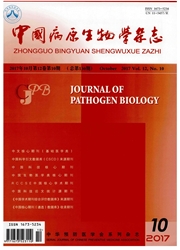

 中文摘要:
中文摘要:
目的了解乌鲁木齐地区婴幼儿轮状病毒腹泻流行情况。方法收集新疆自治区人民医院2007年1~12月住院和门诊0~60月龄婴幼儿腹泻标本376份,ELISA筛查轮状病毒(RV),用RT-PCR对RV毒株进行基因分型。结果共检测376份标本,轮状病毒阳性181份,阳性率48.14%。感染者主要为出生24个月以内的婴幼儿(占98.34%)。9~10月为RV腹泻流行高峰。对161份阳性标本进行G/P基因分型,G1型是主要优势株,占31.68%,其次为G9型(21.12%)、G3型(15.53%)和G2型(14.91%),混合G型感染占14.29%,4例(2.48%)未能分型;P基因型以P[8]为主,占46.58%,其次为P[6](18.63%)、P混合感染(18.01%)和P[4](14.91%),3例(1.86%)未能分型;常见G/P组合G1P[8](24.84%)。结论轮状病毒是乌鲁木齐地区婴幼儿腹泻的主要病原,2007年G1P[8]是主要流行株,G9型成为本地区的第二大优势株。
 英文摘要:
英文摘要:
Objective To investigate characteristics of rotavirus infection among infants and children with diarrhea in Urumqi.Methods Three hundred and seventy-six fecal samples were collected from infants and children ages 1 to 60 months who were seen by or hospitalized at the People's Hospital of Xinjiang Uighur Autonomous Region for diarrhea from January to December 2007.Samples were examined for rotavirus using ELISA.G/P genotypes of rotavirus strains were confirmed by RT-PCR.Results Rotavirus was detected in 181 of 376 samples(48.14%) from infants and children with diarrhea.Of those infants and children,98.34% were children younger than 24 months of age.The peak season of rotavirus diarrhea was September through October.G-typing showed that G1(31.68%) was predominant,followed by G9(21.12%),G3(15.53%),and G2(14.91%).Mixed G infection was noted in 14.29% of samples.Four samples(2.48%) had an indeterminate G type.P-typing showed that P[8] was predominant(46.58%),followed by P[6](18.63%),P-mixed(18.01%),and P[4](14.91%) while three samples(1.86%) had an indeterminate P type.The most common G/P combination was G1P[8](24.84%).Conclusion Rotavirus was the major pathogen responsible for diarrhea in infants and children in Urumqi.G1P[8] was the most prevalent genotype in 2007 and the G9 genotype was the next most predominant strain in the region.
 同期刊论文项目
同期刊论文项目
 同项目期刊论文
同项目期刊论文
 期刊信息
期刊信息
